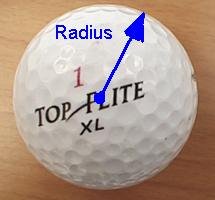

Obtain a meter stick and a cube or a sphere. Both meter sticks and spheres are limited in number, so some groups will have to start with the cube while others will have to start with the sphere.

Suppose a cube has a Length L with an uncertainty e in that length measurement. The Length of one side is therefore L ± e. The volume is equal to (L ± e)³. [Expand this binomial as a group exercise.]
The expansion is L³ ± L²e + L e² ± e³. Note e² is always positive and therefore always tends to increase the volume. The term that causes the most "problems" in terms of accuracy is L²e. L²e is an uncertainty in the area due to uncertainty in the length of the edges of the area. This term can be quite large. If a cube is five centimeters on an edge and the uncertainty is one millimeter, then this term is plus or minus 2.5 cm³. Similar arguments can be made for any volume calculation, there is always an areal error that is "large" compared to the error in measurement of the length of a edge.
These same arguments apply to the calculations of the volume of the sphere.
When adding numbers simply add the numbers and keep the result. This is not wholly correct, but without being able to calculate an actual experimental error in each measurement this procedure will have to suffice.
When multiplying numbers, count the number of digits in each measurements. Keep the number of significant digits that is equal to the number of the digits in the measurement with the fewest digits.
5.4 cm + 11.9 cm + 101.5 cm = 118.8 cm
Often, when adding, the number of decimal places in the measurements will be the same. In this case the number of decimal places in the answer agrees with the number of decimal places in the answer.
5.4 cm × 11.9 cm × 101.5 cm = 6522.39 cm³ = 6500 cm³
Note that only the 6 and the 5 were kept. The number had to be rounded off to the nearest hundreds place to keep only two significant digits. The measurement that limited the problem to two significant digits was 5.4 cm.
Remember that zeros are not counted as significant digits when they are to the left of the decimal place.
Record the volume of the cube and the sphere to the correct significant digits, do not forget to include the units!
Cube ___________________ Sphere: _________________
Page comments to Dana Lee Ling
SC 130 Home page
Lee Ling home page
College of Micronesia-FSM
Copyright ©2000 College of Micronesia-FSM.
Laboratory revised: 29 August 2000
http://www.comfsm.fm/~dleeling/physics/golfdrop.html